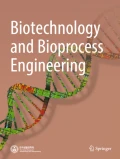Improved β-glucan yield using an Aureobasidium pullulans M-2 mutant strain in a 200-L pilot scale fermentor targeting industrial mass production
Abstract
β-(1→3)-D-glucans with β-(1→6)-glycosidic linked branches are known to be immune activation agents and are incorporated in anti-cancer drugs and health-promoting supplements. β-Glucan concentration was 9.2 g/L in a 200-L pilot scale fermentor using mutant strain Aureobasidium pullulans M-2 from an imperfect fungal strain belonging to A. pullulans M-1. The culture broth of A. pullulans M-2 had a faint yellow color, whereas that of the wild-type had an intense dark green color caused by the accumulation of melanin-like pigments. β-Glucan produced by A. pullulans M-2 was identified as a polysaccharide of D-glucose monomers linked by β-(1→3, 1→6)-glycosidic bonds through GC/MS and NMR analysis. When a conventional medium was used in the culture of A. pullulans M-2 in a 3-L jar fermentor, β-glucan concentration was 1.4-fold that produced by the wild-type. However, when a medium optimized by statistical experimental design was used with dissolved oxygen at 10%, the β-glucan concentration was 9.9 g/L with a yield of 0.52 (g β-glucan/g consumed sucrose), 2.9-fold that of the wild-type. This level of productivity was reproduced when the fermentation was scaled up 200-L. The industrial production of high β-glucan without melanin-like pigments is highly expected, as a health-promoting supplement or functional food.
References
https://doi.org/10.1007/s12257-013-0516-9
- Volume 18, pages 1083–1089, (2013)
- Research Paper
- Published:
- Volume 18, pages 1083–1089, (2013)

